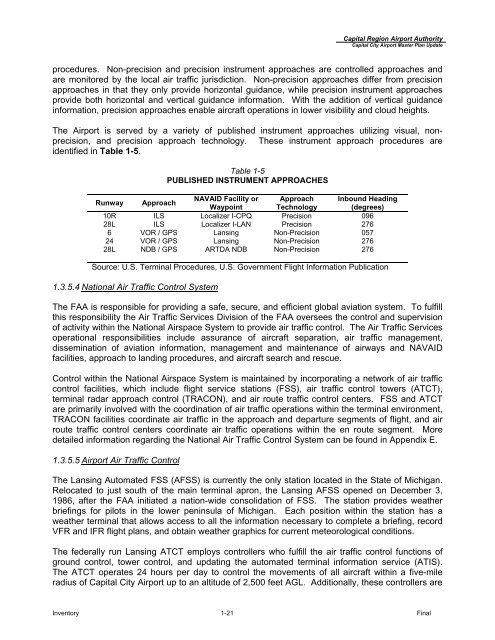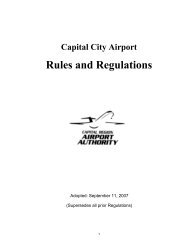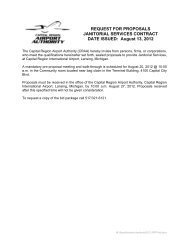Master Plan Update (pdf) - Lansing/Capital City Airport
Master Plan Update (pdf) - Lansing/Capital City Airport
Master Plan Update (pdf) - Lansing/Capital City Airport
You also want an ePaper? Increase the reach of your titles
YUMPU automatically turns print PDFs into web optimized ePapers that Google loves.
<strong>Capital</strong> Region <strong>Airport</strong> Authority<br />
<strong>Capital</strong> <strong>City</strong> <strong>Airport</strong> <strong>Master</strong> <strong>Plan</strong> <strong>Update</strong><br />
procedures. Non-precision and precision instrument approaches are controlled approaches and<br />
are monitored by the local air traffic jurisdiction. Non-precision approaches differ from precision<br />
approaches in that they only provide horizontal guidance, while precision instrument approaches<br />
provide both horizontal and vertical guidance information. With the addition of vertical guidance<br />
information, precision approaches enable aircraft operations in lower visibility and cloud heights.<br />
The <strong>Airport</strong> is served by a variety of published instrument approaches utilizing visual, nonprecision,<br />
and precision approach technology. These instrument approach procedures are<br />
identified in Table 1-5.<br />
Table 1-5<br />
PUBLISHED INSTRUMENT APPROACHES<br />
Runway Approach<br />
NAVAID Facility or<br />
Waypoint<br />
Approach<br />
Technology<br />
Inbound Heading<br />
(degrees)<br />
10R ILS Localizer I-CPQ Precision 096<br />
28L ILS Localizer I-LAN Precision 276<br />
6 VOR / GPS <strong>Lansing</strong> Non-Precision 057<br />
24 VOR / GPS <strong>Lansing</strong> Non-Precision 276<br />
28L NDB / GPS ARTDA NDB Non-Precision 276<br />
Source: U.S. Terminal Procedures, U.S. Government Flight Information Publication<br />
1.3.5.4 National Air Traffic Control System<br />
The FAA is responsible for providing a safe, secure, and efficient global aviation system. To fulfill<br />
this responsibility the Air Traffic Services Division of the FAA oversees the control and supervision<br />
of activity within the National Airspace System to provide air traffic control. The Air Traffic Services<br />
operational responsibilities include assurance of aircraft separation, air traffic management,<br />
dissemination of aviation information, management and maintenance of airways and NAVAID<br />
facilities, approach to landing procedures, and aircraft search and rescue.<br />
Control within the National Airspace System is maintained by incorporating a network of air traffic<br />
control facilities, which include flight service stations (FSS), air traffic control towers (ATCT),<br />
terminal radar approach control (TRACON), and air route traffic control centers. FSS and ATCT<br />
are primarily involved with the coordination of air traffic operations within the terminal environment,<br />
TRACON facilities coordinate air traffic in the approach and departure segments of flight, and air<br />
route traffic control centers coordinate air traffic operations within the en route segment. More<br />
detailed information regarding the National Air Traffic Control System can be found in Appendix E.<br />
1.3.5.5 <strong>Airport</strong> Air Traffic Control<br />
The <strong>Lansing</strong> Automated FSS (AFSS) is currently the only station located in the State of Michigan.<br />
Relocated to just south of the main terminal apron, the <strong>Lansing</strong> AFSS opened on December 3,<br />
1986, after the FAA initiated a nation-wide consolidation of FSS. The station provides weather<br />
briefings for pilots in the lower peninsula of Michigan. Each position within the station has a<br />
weather terminal that allows access to all the information necessary to complete a briefing, record<br />
VFR and IFR flight plans, and obtain weather graphics for current meteorological conditions.<br />
The federally run <strong>Lansing</strong> ATCT employs controllers who fulfill the air traffic control functions of<br />
ground control, tower control, and updating the automated terminal information service (ATIS).<br />
The ATCT operates 24 hours per day to control the movements of all aircraft within a five-mile<br />
radius of <strong>Capital</strong> <strong>City</strong> <strong>Airport</strong> up to an altitude of 2,500 feet AGL. Additionally, these controllers are<br />
Inventory 1-21 Final




